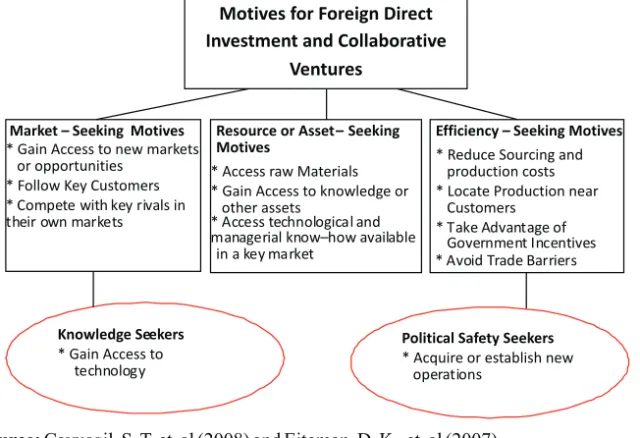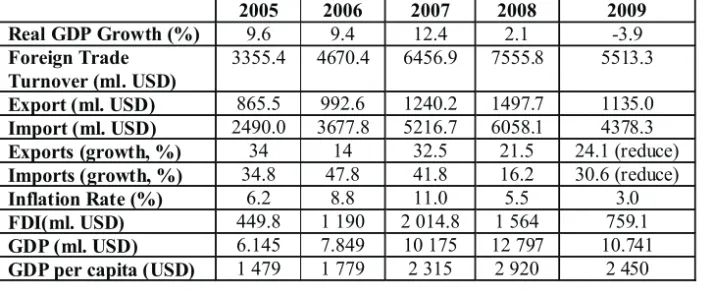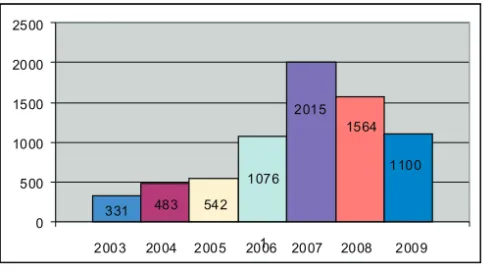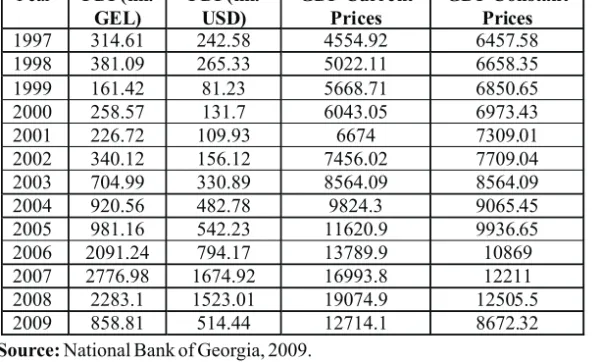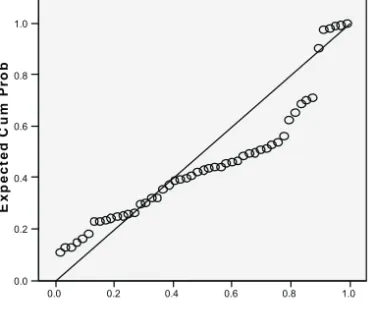Attracting Investors: Case of Impact of FDI on the
Achievements of Economic Growth in Georgia
Tea KBILTSETSKHLASHVILI
Abstract
The paper examines the role and importance of Foreign Direct Investment (FDI) in Georgia after transition period and its’ impact on economic growth of the country and analysing ways for attracting FDI. It focuses on effectiveness of investment climate in Georgia after transition period and on analysis of results of global crisis on Georgia’s investment. Despite the improvement of the investment climate in Georgia, there still remain a number of persistent problems on which FDI cannot maximize its impact. The study gives recommendations how to attract foreign investors and in which particular fields funds are needed and concomitantly their impact can be maximized. Main tendencies of improving investment climate and economic growth of the country are considered. A regression analysis backs up the conclusion.
Keywords: foreign direct investment, transition period, global crisis, economic growth
“One dollar of FDI is worth no more (and no less) than a dollar of any other kind of investment.”
Dani Rodrik
Introduction
The level of existence of investing resources in economy, formation mechanisms of favourable climate for attracting foreign investment and its effective usage is one of the important factors for stable and safe development of national economy, systematic rising of population living standard.
As Ayanwale (2007) states, most countries strive to attract FDI because of its acknowledged advantages as a tool of economic development.
The research paper examines the transformation process of investment climate of the country during the transition period from “Rose
1
Revolution” to a democratic one. The paper also focuses on effectiveness of investment climate in Georgia after transition period and on analysis of results of global crisis on Georgia’s investment. As Unanyants (2003) remarks, investments are important to a country’s economy because it acts
as a driving force behind long – term economic growth. The study explains
and deals with the real market situation, the economic hardships, its’ disadvantages and discusses reasons for decreased investment process and provides recommendations how to increase the competitiveness of the country’s investment climate to retain existing and attract new foreign and domestic investors.
As a result of reforms and the liberal economic policy carried out by Government Georgia is becoming an attractive location for investments.
One of the major determinants of a country’s economic development and wellbeing are the indicators of investment structure and
1
volume. One of the key factors in farther economic expansion of Georgia is the development of competitive economy that cannot be achieved without FDI. The availability of strategic or natural resources and/or skilled labor (especially if costs are low relative to productivity) tends to attract investors. Given these fundamentals, government policies can be important and countries that provide a welcoming ‘investment climate’ will attract more investment (Morrissey, 2006).
Kapuria-Foreman (2007) considers that increasing the protection of property rights, reducing government intervention and lowering barriers to capital flows and foreign investments are all likely to increase FDI. On the other hand, Biglaiser and DeRouen (2006) argue that attempts to minimize expropriation risk complement domestic financial and trade reforms, which enhances interest of foreign investors.
Investment Policy Review and Impact of FDI on Economic Growth
After the “Rose Revolution”, Georgia showed quite an impressive economic dynamics. Despite the improvement of the investment climate in Georgia there still remain a number of persistent problems about defending property, financial transparency, stability, and outdated material – technical
base, underdeveloped infrastructure that fear investors. By consideration
these and other factors, in the respect of effectiveness, FDI still do not have enough and corresponding impact on employment and social existence or wellbeing of society.
Given the small size of the domestic market, sustained high growth rates will only be achieved through a stronger expansion in export activities, especially of those in which Georgia has a comparative advantage (e.g., hazelnuts; horticulture; tea and wine; light manufacturing (garments and wood processing); industrial minerals and stone processing; information technology and engineering; and tourism) and have the potential to generate new job opportunities, such as agro-processing.
Increasing exports can help job creation. In addition to the above
mentioned, it should be taken into consideration that according National Bank of Georgia, Investment flows has significantly decreased after
2
Ossetian - Georgian war of august 2008 , thus causing poverty, of Economic Growth in Georgia
2
unemployment and insecurity that become serious problems for the majority of Georgia’s population. Attracting FDI to Georgia, after “Rose Revolution”, and slowing down of this process, after Georgian – Ossetian war in Georgia, a country with low national savings but rich natural resources and insufficient capabilities of establishing new capacities for boosting economic prosperity, is an issue of major importance nowadays. All the above considerations have made the investment climate a critical issue for future growth and development of Georgian economy. The challenges are to restore the credibility and stability of the financial system and to provide the “right” stimulus to investment and renew the commitment to an open economy.
In assessing the potential for investment and the policy options of attracting investment it is important to underlie motives behind the investments in Georgia. In general, Cavusgil (2008) classifies three specific motives for FDI and Eiteman (2007) adds two more strategic motives for driving the decision to invest abroad and become a Multinational Enterprise (MNE):
Figure 1.1. Firm Motives for Foreign Direct Investment and Collaborative Ventures.
Source: Cavusgil, S. T, et. al (2008) and Eiteman, D. K., et. al (2007).
Motives for Foreign Direct Investment and Collaborative
Ventures
Market – Seeking Motives
* Gain Access to new markets or opportunities
* Follow Key Customers
Resource or Asset – Seeking Motives
* Access raw Materials * Gain Access to knowledge or
other assets
Efficiency – Seeking Motives
* Reduce Sourcing and production costs * Locate Production near
Customers
Knowledge Seekers
According to Cavusgil (2008) and Eiteman (2007), managers have opportunity to seek new market opportunities for FDI either as a result of unfavorable developments in their home market or attractive opportunities abroad.
Overview of Georgian Economy
According to “Ease of Doing Business 2009" report of the World Bank and International Finance Corporation (IFC) and also the Ministry of Economic Development of Georgia, in terms of the pace of economic reforms and ease of doing business, the World Bank ranked Georgia on 11th place in 2009, 15th place in 2008 up from 37th in 2007, 112th in 2006 and 134th in 2005. The Global Competitiveness Report 2008-2009 prepared by World Economic Forum lists the most problematic factors for doing business in Georgia as:
Policy instability...12.6 Inflation ...12.5 Inadequately educated workforce...12.4 Access to financing...11.6 Inadequate supply of infrastructure ...10.5 Government instability/coups ...9.0 Poor work ethic in national labor force ...7.6 Inefficient government bureaucracy... ...7.4 Tax regulations ... ....6.2 Corruption...3.2 Tax rates ... ..3.1 Foreign currency regulations... .2.2 Restrictive labor regulations... 0.6 Poor public health...0.5 Crime and theft ... ...0.4
According to the Global Competitiveness Report, while investing resources in the country investors are first interesting in countries’ political situation and the reason that they are not investing resources is high political instability in Georgia and they assign it 12.6%, next problematic factor is high inflation – 12.5%, then comes inadequately educated workforce with 12.4%, access to financing with 11.6%, 6.2% comes on tax regulations, as corruption rate has dramatically decreased in the country this become less problematic issue for investors and it has just 3.2% and so on.
European Bank for Reconstruction and Development (EBRD) transition report for 2005, Georgia is the best performing country in terms of improvement of Tax Administration among the countries with transition economies.
Worth mentioning that Georgia and Caucasus region attracts investors with its’ suitable geograpical location, concentration of natural and energy resources, cheap and more or less educated workforce, also tradition of production and manufacturing, so investments to Georgia mostly were caused due to its location as a transit country for energy transportation.
The Georgian government has made a commitment to greater transparency and simplicity of regulation. Georgia’s fast paced economic reforms, which included new tax and custom codes, reduced the level of corruption and aggressive privatization and had created more attractive business climate than it was in previous years (Akhmeteli, 2008).
The tax system is one of the most basic economic mechanisms determining the development of economics. So, Georgia had a great experience with respect to acceleration of the economic growth and formation of investment-friendly business environment for foreign investors. The positive rearrangements of the tax system have had a decisive influence on the rates of economic growth in Georgia during 2003-2010.
Georgia has liberalized its economy to some extent in recent years. Attention was focused in following areas: a) Creating a more stable macroeconomic environment. b) Liberalizing of controls on foreign exchange transactions. c) Trade liberalization. d) Rationalizing tax structures. e) Liberalizing investment laws and restrictions, and f) Promoting foreign investment and exports. (FIAS, 2001)
budget expenditure over the same period grew by 2.5 times and exceeded GEL 6 billion (35.8 percent of GDP). The invasion of Russian troops into Georgia in August 2008, however, changed the country’s economic situation in essence (Kakulia, 2008, 7).
The macroeconomic indicators of Georgia for 2005-2009 years are presented in Table 1.1.
Table 1.1. Main Economic Indicators(2005 - 2009).
Source: Ministry of foreign affairs of Georgia (2009).
According to Table 1.1., the GDP growth rate in 2008 was 2.1 per cent, while it has dramatically reduced to -3.9 in 2009. GDP in market prices amounted to 19 070 ml. GEL (12 797 ml. USD) and GDP per capita equaled to GEL 4 352 (2 920 USD) while by 2009 preliminary data GDP in market prices amounted to 3 846 ml. GEL (10. 741 ml. USD) and GDP per capita equaled to 2 450 USD in 2009.Retrieved from www. mfa.gov.ge) Georgian Economic Review of 2009 reported following: The FDI's in 2008 amounted 1 564 ml. USD while it has decreased and amounted 124.7 ml. in 2009 due to different reasons, especially the Ossetian - Georgian war.USD and foreign trade turnover amounted to 5513.3 ml. USD in 2009 (37.2% reduce in comparison with the last year. Net FDI forecast for 2009 was at US$1.1 bn., 8.4% of ‘09 GDP (Georgian Economic Overview, 2009).
FDI inflows were too small in 2003, just 8.3% compare previous years, it made 331 ml USD in 2003, increased till 483 million USD in 2004, which is 9.4% more, 542 USD, which is 8.5% more in 2005, than 13.9% increase in 2006 and the largest investment in the Georgian economy and highest FDI inflow was in 2007 – 2015 USD, 19.8% more than in previous
2005 2006 2007 2008 2009
Real GDP Growth (%) 9.6 9.4 12.4 2.1 -3.9
Foreign Trade Turnover (ml. USD)
3355.4 4670.4 6456.9 7555.8 5513.3
Export (ml. USD) 865.5 992.6 1240.2 1497.7 1135.0
Import (ml. USD) 2490.0 3677.8 5216.7 6058.1 4378.3
Exports (growth, %) 34 14 32.5 21.5 24.1 (reduce)
Imports (growth, %) 34.8 47.8 41.8 16.2 30.6 (reduce)
Inflation Rate (%) 6.2 8.8 11.0 5.5 3.0
FDI(ml. USD) 449.8 1 190 2 014.8 1 564 759.1
GDP (ml. USD) 6.145 7.849 10 175 12 797 10.741
GDP per capita (USD) 1 479 1 779 2 315 2 920 2 450
years. After this period investment decreased by 10.1% in 2008 and by 8.4% in 2009.
Figure 1.2. Net FDI Inflows (US $ ml.)
The process of democratization and transition to the market economy in Georgia has in the first place brought changes and positive consequences. Georgian market economy and increased investment flow influenced in a good way on Georgian family but Georgia still needs economic development and reduction of poverty in the country, so the problems with special impact on the welfare of the country and its citizens, economic situation and poverty must be solved. We think that production factors can be increased only via attraction of foreign direct investments.
Since it is not easy to revive the confidence of investors, especially under the global financial crisis, the country should apply the existent political risk insurance mechanisms. Country needs to apply extraordinary methods for the attraction of new investors. In this regard it seems reasonable to grant them some of those privileges, including tax breaks which can be enjoyed only by he investors operating under effective legislation in the free industrial zone, for a certain period and throughout the country. Moreover, special benefits should be offered to those investors who would invest their capital into export – oriented industries and create new jobs.
Research Methodology
Regression analyze which was conducted to determine the relationship between Gross Domestic Product (GDP) and FDI illustrates the points and tendencies for investment climate for 13 years (1997 - 2009), states the value of FDI influence for the economic development and growth
331 483 542 1076
2015 1564
1100
0 500 1000 1500 2000 2500
1
of prosperity, wellbeing. Regression analysis helped us to understand how FDI is related to GDP and economic growth and explore the forms of these relationships. It was elucidated that FDI positively influences economic growth in Georgia and thus the increase in FDI inflows is of immense importance for the economic prosperity of our country. So, economic growth rate influences positively the business climate as it reflects an improvement in economic performance meaning that economic growth increases good business climate that will lead to wage rate increases, higher returns to capital that should lead to faster accumulation and growth for the typical firms in sectors that should be expanding as the country accumulates capital. As capital is accumulated diminishing returns reduce profitability and the growth rate slows down. High GDP will increase employment and this will attract foreign investors to the country. Economists all over the world agree that there is a certain positive relationship between GDP and FDI inflows.
Empirical results of numerous econometric researches have shown that FDIs include economic growth (Grybaite, 2007, 112).
Regression analysis estimated the conditional expectation of the dependent variable (FDI) given the independent variable (GDP). Regression analysis helped us to understand how FDI is related to GDP, explore the forms of these relationships. Our method have been developed for robust regression that involves correlated responses such as time series data (1997 – 2009), growth curves, graphs and other data objects.
Table 1.2. FDI Dynamics in 1997 – 2009.
Source: National Bank of Georgia, 2009.
Year FDI (ml. GEL)
FDI (ml. USD)
GDP Current Prices
GDP Constant Prices
1997 314.61 242.58 4554.92 6457.58
1998 381.09 265.33 5022.11 6658.35
1999 161.42 81.23 5668.71 6850.65
2000 258.57 131.7 6043.05 6973.43
2001 226.72 109.93 6674 7309.01
2002 340.12 156.12 7456.02 7709.04
2003 704.99 330.89 8564.09 8564.09
2004 920.56 482.78 9824.3 9065.45
2005 981.16 542.23 11620.9 9936.65
2006 2091.24 794.17 13789.9 10869
2007 2776.98 1674.92 16993.8 12211
2008 2283.1 1523.01 19074.9 12505.5
2009 858.81 514.44 12714.1 8672.32
FDI flow represents a positive and significant determinant of GDP. We used this table to find out the relationship between GDP growth rate and FDI.
Research Findings and Results
FDI and GDP are measured in millions of Georgian Lari (GEL) in current prices. The main regression results indicate that FDI has a positive overall effect on economic growth. Here is a summary of these two variables:
Table 1.3. Case Summaries.
To see the true relationship between GDP and FDI the time variable should be included in our regression. Regression results and interpretation are as follows:
Table 1.4. Regression Results and Interpretation
Figure 1.3. Time Trend of FDI
FDI (Million GEL) GDP Current Prices (Millions GEL)
Mean 241.1645 2509.8194
Minimum 25.48 1005.14
Maximum 945.05 5183.85
Std. Deviation 241.58118 1242.18059
Dependent Variable: GDP Current Prices
Coefficients 95% CI
B Std.
Error
t Statistics
Lower Bound Upper Bound
(Constant) 1273.335 258.753 4.921
9.963 1.010
753.077 1793.593
FDI 4.189 .420 3.344 5.034
QUARTER 91.592 90.695 -90.763 273.948
D ate. F o r m at: "Q Q YYY Y"
Q 3 2 0 0 9 Q 1 2 0 0 9 Q 3 2 0 0 8 Q 1 2 0 0 8 Q 3 2 0 0 7 Q 1 2 0 0 7 Q 3 2 0 0 6 Q 1 2 0 0 6 Q 3 2 0 0 5 Q 1 2 0 0 5 Q 3 2 0 0 4 Q 1 2 0 0 4 Q 3 2 0 0 3 Q 1 2 0 0 3 Q 3 2 0 0 2 Q 1 2 0 0 2 Q 3 2 0 0 1 Q 1 2 0 0 1 Q 3 2 0 0 0 Q 1 2 0 0 0 Q 3 1 9 9 9 Q 1 1 9 9 9 Q 3 1 9 9 8 Q 1 1 9 9 8 Q 3 1 9 9 7 Q 1 1 9 9 7 F D I (M il li o n G E L )
1 ,0 0 0 .0 0
80 0 .0 0
60 0 .0 0
40 0 .0 0
20 0 .0 0
We can see a lot of volatility in FDI; the reason is that data is not
seasonally adjusted. The drop in FDI in 2009 is the result after Ossetia –
Georgian war. Due to political instability in the country, foreign investors lost interest to invest their resources in Georgia.
Figure 1.4. Frequency Histogram
The graph in figure 1.4. obtained from dependent variables, GDP current prices, by which we found the mean (1.87) and standard deviation (0.99) and draw a frequency histogram.
Figure 1.5. Normal P-P Plot of Regression Standardized Residual
F
re
q
u
e
n
c
y
20
15
10
5
0
Dependent Variable: GDP_current_Prices
Mean =-1.87E-16 Std. Dev. =0.99
N =51
1.0 0.8 0.6 0.4 0.2 0.0
E
x
p
e
c
te
d
C
u
m
P
ro
b
1.0
0.8
0.6
0.4
0.2
0.0
Dependent Variable: GDP_current_Prices
Using dependent variable GDP current prices we found expected cumulative probability and draw normal P-P plot of regression standardized residual.
Table 1.5. Model Summary
We used dependent variable, GDP current prices and constant predictor FDI in the model summary analysis. If FDI is taken as an independent variable while denoting GDP as a dependent variable, the following results obtained: according to the correlation analysis, the goodness of fit R-squared is 0.674, that is, 67% of GDP variability is explained by changes in FDI, and 33% - by other factors. The correlation coefficient R equals 0.821, demonstrating a strong correlation between GDP and FDI (based on the data of 1997-2009). R Square shows us that 67.4% variation in GDP can be explained by FDI. Looking at t-statistics we can conclude that FDI is statistically significant even at 99% significance level. The standard error of a method of measurement or estimation is 716.09 (table 1.5.) and it shows the standard deviation of the sampling distribution associated with our estimation method. It refers to an estimate of that standard deviation of 0.99, derived from a particular sample we used to compute the estimate using GDP current prices (figure 1.4.). The sample mean is the estimator of a population mean and it is 1.87 (figure 1.4.). The standard error of the mean refers to an estimate of standard deviation, computed from the sample of data being analyzed.
Table 1.6. Coefficients
Dependent variable: GDP
Predictors: (Constant), FDI (Million GEL) Method: Least Squares
Sample (adjusted): 1997 – 2009 Included observations:
Model R R Square Adjusted R Square Std. Error of the Estimate
1 .821(a) .674 .668 716.09535
Model
Unstandardized Coefficients
Standardized
Coefficients t Sig.
95% Confidence Interval for B
B Error Std. Beta Bound Lower Bound Upper B Error Std.
1 (Constant)
1491.542 142.391 10.475 .000 1205.396 1777.688
FDI (Million
The regression analysis yields the following relationship: a one-percent increase in FDI leads to 0. 42 one-percent increase in GDP (estimated coefficient for FDI is 4.2, which means that if foreign direct investment increases by 1 million Gel, expected increase in GDP is 4.2 million GEL). In 95% cases it will increase from 3.38 (that is calculated by 95% confidence interval for B) to 5.06 million GEL (Standard error). We used standardized coefficients or beta coefficients to determine what kind of effect independent variables (GDP) have on the dependent variable (FDI)
in our multiple regression analysis and it is 82.1%. Looking at t-statistics
we can conclude that FDI is statistically significant even at 99% significance level.
Table 1.7. Residuals Statistics
We used residual statistics to measure the difference between the sample and the estimated function value.
As a result of the regression analysis we can say that FDI positively influences economic growth in Georgia and thus the increase in FDI inflows is of immense importance for the economic prosperity of our country. The greatest importance, when talking about FDI inflows in Georgia, pertains to the existing investment climate, which is the major determinant of the amount of FDI that flows into the country yearly.
Conclusion and Recommendations
The process of democratization and transition to the market economy in Georgia has in the first place brought changes and positive consequences but Georgia still needs economic development and reduction
of poverty in the country. We think that production factors can be increased
only via attraction of foreign direct investments.
Since it is not easy to revive the confidence of investors, especially under the global financial crisis, the country should apply the existent
Minimum Maximum Mean Std. Deviation N
Predicted Value 1599.1058 5481.8735 2509.8194 1020.03722 51
Residual -869.42590 2661.01367 .00000 708.89823 51
Std. Predicted
Value -.893 2.914 .000 1.000 51
Std. Residual -1.214 3.716 .000 .990 51
political risk insurance mechanisms. Country needs to apply extraordinary methods for the attraction of new investors. In this regard it seems reasonable to grant them some of those privileges, including tax breaks which can be enjoyed only by the investors operating under effective legislation in the free industrial zone, for a certain period and throughout the country. Moreover, special benefits should be offered to those investors who would invest their capital into export – oriented industries and create new jobs.
To improve investment climate and attract more FDI has vital importance for the country. Country should encourage more export promotion and less import substitution strategy. Georgia attracts Foreign Direct Investors but still needs improvements in the business climate for the implementation of a few visible actions in the strategy for attracting FDI. For this reason, it is very important to improve the mechanisms for protection of shareholders rights and equitable treatment of shareholders (to motivate potential investors to invest in Georgian economy). The highest priority should be given to strengthening the legal and regulatory frameworks to ensure effective implementation and enforcement of existing laws and regulations needed for proper functioning of the capital market. Effective implementations require sustained levels of investigation and enforcement and credible sanctions that are severe enough to deter violations. As we told, priority should be given to the
following areas: a) Intensify implementation and enforcement; b) Ensure
clarity and coherence; c) Facilitate the development of a corporate governance culture in the private sector; d) Ensure continuing support and review of progress and e) Support and enhance the development of training programs.
opinion, biased. It can be said that the reforms in judiciary lag behind the liberalization of business environment. Institutional reforms conducted in many spheres in Georgia during last year, stable political and economic situation attracted foreign investors. The implemented tax reform system led to positive changes in business environment in Georgia. It achieved relatively high rates of economic development, which is reflected in GNP growth rates. Other indicators of the growth of Georgian economy show positive indicators which was expressed in export growth. However, it is necessary to improve the tax system. More attention should be paid to reducing work income tax and to improve tax administration. However, recently Georgia has been hindered by political, financial and economic crises and a slow economic growth. In addition to the Russian war and some internal factors, global financial crisis contains more than enough risks (including threat of slowing down the growth of Georgia’s economy and threat of termination or reduction of investment flows) for Georgia to experience serious problems with respect to maintaining economic well –being.
Considering the fact that investment inflow has dramatically decreased in the country, effective investment policy should be formed in order to attract investors by:
a) Improving country’s image within the investment community as a favorable location for investment.
b) Generating investment directly (investment generating activity) and c) Provide services and incentives to prospective and current investors.
References
Akhmeteli, N. (February – March, 2008), “FDI in 2008: $2 billion?” Investor.ge, Issue 1, Georgia, Retrieved April 25, 2009, from
www.investmentguide.ge/files/250_288_503744_MerrillLynchEconomicFocusonGeor gia2008.pdf
Ayanwale, A.B (2007) “FDI and Economic Growth: Evidence from Nigeria” AERC Research Paper 165, African Economic Research Consortium, Nairobi, Retrieved April 25, 2009 from http://www.aercafrica.org/documents/RP_165.pdf
Biglaiser, Glen, 1963- & DeRouen, Karl R., 1962-. (2006). Economic reforms and inflows of foreign direct investment in latin america. Latin American Research Review 41(1), 51-75. Retrieved January 24, 2009, from Project MUSE database.
Cavusgil, S. T., Knight, G. A., & Riesenberger, J. R. (2008). International business: Strategy, management, and the new realities. Upper saddle River, N.J: Pearson Prentice Hall.
Department of Statistics of Georgia, 2009. FDI in Georgia. Report of Statistics Department of Georgia, Retrieved April 20, 2009 from
http://www.geostat.ge/cms/site_images/_files/georgian/bop/FDI%202009%20_Geo.pdf
Department of Statistics of Georgia, 2009. GDP of Georgia. Press Release of Statistics Department of Georgia, Retrieved April 20, 2009 from
http://www.geostat.ge/cms/site_images/_files/georgian/nad/GDP_2009_press-release_Geo.pdf
Doing Business 2009. (2008). A copublication of the World Bank, the International Finance Corporation, and Palgrave Macmillan. The International Bank for
Reconstruction and Development / The World Bank. Retrieved April 27, 2009, from http://www.doingbusiness.org/reports/doing-business/doing-business-2009
EBRD. (2005). Transition Report 2005: Business in transition. London: European Bank for Reconstruction and Development. Retrieved March 15, 2009 from
http://www.ebrd.com/downloads/research/transition/TR05.pdf
Eiteman, D. K., Stonehill, A. I., & Moffett, M. H. (2007). Multinational business finance. Frenchs Forest, 11th edition, N.S.W: Pearson Education Australia.
FIAS (2001). Study of Administrative Barriers to Investment within Subjects of the Russian Federation. pp:1. Retrieved on 12 May, 2009 from
http://www.ifc.org/ifcext/fias.nsf/AttachmentsByTitle/FIAS_Resources_RUSSIA2_Ap pendix.pdf/$FILE/FIAS_Resources_RUSSIA2_Appendix.pdf
Georgian Economic Overview (May, 2009). Retrieved September 10, 2009 from www.georgia.gov.ge
Grybaite, V., & Tvaronaviciene, M. (2007). Quantitative Economic Analysis of Foreign Direct Investment in Lithuania, Retrieved September 5, 2009 from www.doaj.org, 112-115.
Kakulia, R. (2009). The Role of FDI in Transitional and Developing Countries and the Benefit-Maximizing Government Policies.
Kapuria-Foreman, Vibha. (2007). Economic freedom and foreign direct investment in developing countries. The Journal of Developing Areas 41(1), 143-154. Retrieved January 24, 2009, from Project MUSE database.
Milner, C., Morrissey, O., & Zvogu, E. (2007). Adjusting to Bilateral Trade Liberalization under an EPA: Evidence for Mauritius, University of Nottingham, School of Economics: CREDIT Research Paper 07/11.
http://www.amcham.ge/photos/luncheon_2009-0325/Ministry%20of%20Economic%20Development.pps#289,2
Ministry of foreign affairs of Georgia. (2009a). Investment Overview. Retrieved on 15 September, 2009, from http://www.mfa.gov.ge/index.php?lang_id=ENG&sec_id=76
Ministry of foreign affairs of Georgia. (2009b). Macroeconomic Overview. Retrieved on 15 September, 2009, from
http://www.mfa.gov.ge/index.php?lang_id=ENG&sec_id=73&info_id=9423
Morran, T. H. (2009). How Does FDI Effect Host Country Development? Using Industry Case Studies to Make Reliable Generalizations.
Morrissey, O. (2008). Investment Provisions in Regional Integration Agreements for Developing Countries. University of Nottingham, School of Economics: CREDIT Research Paper 08/06, 2008. Retrieved March 15, 2009, from
http://www.nottingham.ac.uk/credit/documents/papers/08-06.pdf
Porter M.E. and K. Shwab (2008). The global competitiveness report 2008-2009, World Economic Forum, Geneva, Switzerland. Retrieved December 21, 2009 from
https://members.weforum.org/pdf/GCR08/GCR08.pdf
Schmidt, M. (2007). Recommendations on Measures to Promote Investment with regard to EU-Georgia Action Plan, GEPLAC Policy Note, #6. Retrieved April 25, 2009, from www.geplac.gewww.geplac.org/newfiles/reports/Michael Schmidt. pdf
Schmidt, M. (2007). Foreign Direct Investment to Georgia: Can Active Investment Promotion Policies Make A Difference? 1. Retrieved March 23, 2009, from www.geplac.org/newfiles/reports/4.Michael Schmidt. pdf
Unanyants, E., Sharashenidze, T., Ghvinjilia, L., Dzigrashvili, R., Tskitishvili, I & Gorgiladze, I. (2003), “Assessment of Investment Climate in Georgia”, Research paper, Georgian Institute of Public Affairs. Retrieved March 28, 2009, from
http://www.gipa.ge/data/pdf/inv_cl_res.pdf
United Nations Conference on Trade and Development (2007). World Investment Report. United Nations publication, sales no. E.07.II.D.9, New York and Geneva. Retrieved November 29, 2009, from http://www.unctad.org/en/docs/wir2007p1_en.pdf
United Nations Conference on Trade and Development, UNCTAD Investment Brief. (2009). #1.
